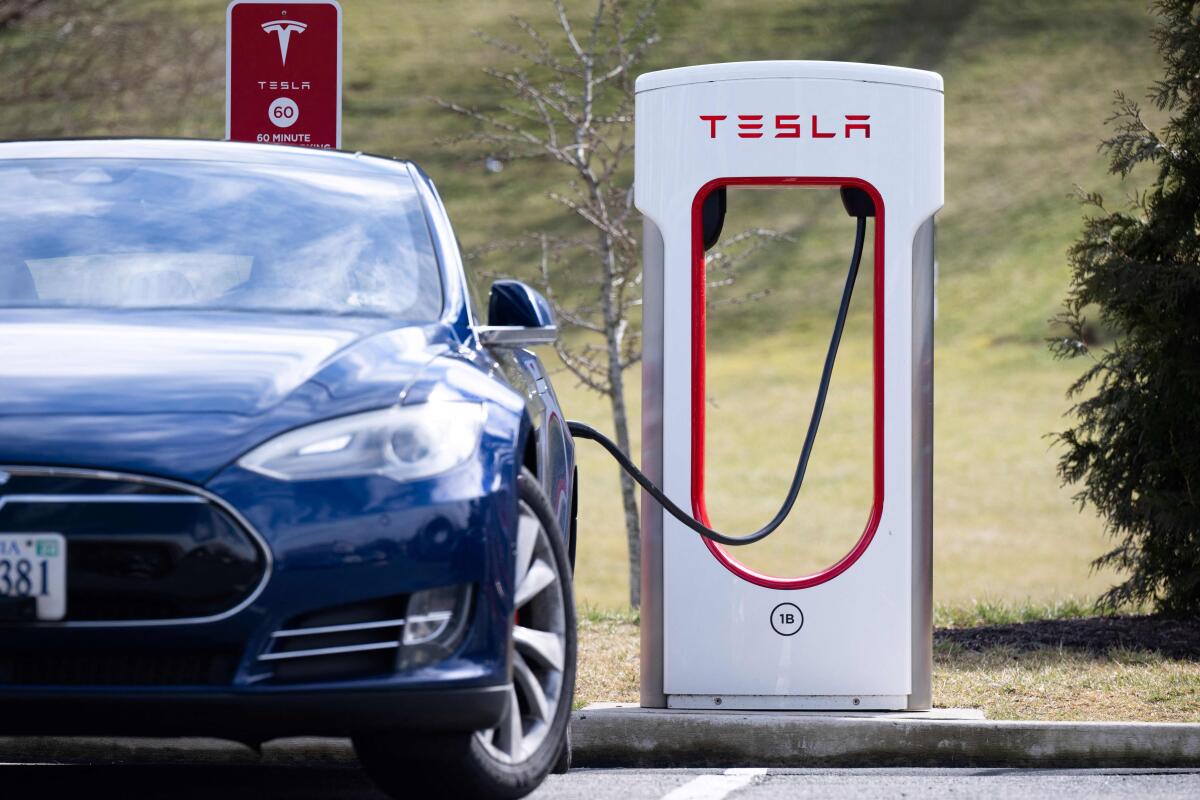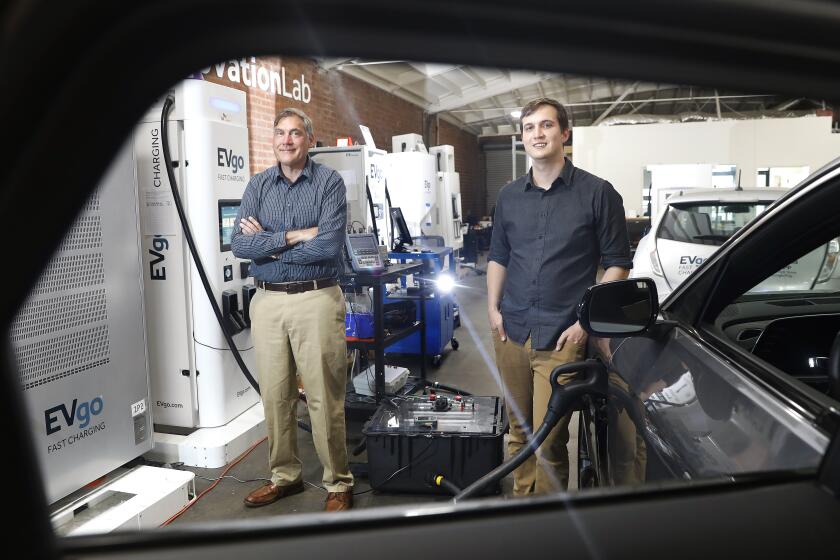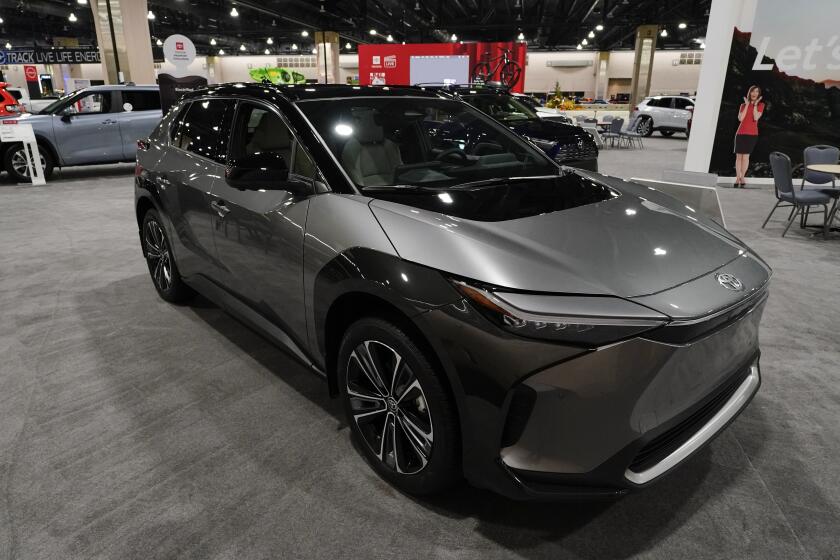A heat wave will cook your EV’s battery, if you let it

- Share via
Consider it ironic, or at least a little poetic: Electric vehicles, great for combating climate change, don’t do well in extreme heat. It’s a paradox being thrown into relief as multiple U.S. states bake under heat waves that are becoming more frequent and more intense.
High temperatures aren’t kryptonite for battery-powered vehicles. An EV in a hot climate has to work harder to keep its battery and its passengers cool, but the car will function just fine. On a chemical level, though, extreme heat is akin to heart disease for EV batteries, or a slow-moving form of cancer.
That’s because when temperatures climb, the ions in a car battery speed up. Once that happens, they often have trouble attaching to the anode or cathode. The pressure and speed can also create small cracks, which slow chemical reactions and make for less usable battery life.
To some degree, this happens with any fast-charging cycle.
Using a Tesla Supercharger will move ions more quickly than plugging into a wall outlet, and the heat generated by rapid charging is one reason smartphone batteries aren’t speedier. But on extremely hot days, the ions in an EV battery whizz around even when the car isn’t driving or plugged in, and that can curtail range irreversibly.
As the market for electric vehicles expands, the reliability record for public EV chargers is poor, causing many would-be EV buyers to question whether it’s time to make the switch.
“The worst case really is a car that sits in an unconditioned garage in Phoenix all summer without being plugged in,” said Scott Case, co-founder and chief executive of Recurrent, a startup that generates battery health reports for EV customers and dealers. “That will cook the battery really quickly.” If the car is plugged in, it can use charging power to keep its battery cool.
Cold weather also affects EV batteries. The colder it is, the slower the chemical reactions and the less charge a battery holds. But those losses are short-term; come spring, a battery in snowy Michigan or chilly Maine will recover its full function, whereas heat can bring down maximum range in perpetuity.
“You can coach people, but you can’t say ‘Don’t live in Phoenix,’” Case said. “That one feels a little bit unfair.”
As EV adoption progresses in tandem with rising temperatures, drivers all over the world will have to get familiar with best practices for maintaining battery life.
In the U.S. in particular, some of the highest levels of EV adoption are in hot places. California, Florida, Texas, Arizona and Georgia are home to 56% of the nation’s battery-powered cars, according to the Department of Energy.
The bZ4X. The EQE. The e:Ny1. Carmakers are all-in on electric options but branding them has been a half-baked mashup of ideas.
Fortunately, nurture can neutralize much of nature’s heat handicap.
“Anywhere I can find shade in a hot Texas summer, I try to find it,” said Skyler Williams, an Austin-based entrepreneur who boned up on battery chemistry and maintenance before buying his Rivian R1S last August. “It doesn’t matter if I’m going to be in the grocery store for 10 minutes or two hours. Better safe than sorry.”
Williams also follows other good rules of thumb: He charges at fast stations only when he has to, always leaves his truck plugged in when it’s parked in the garage, seldom charges the battery past 80% and uses Rivian’s app to open the windows if he’s away from the truck on a hot day. After almost a year, his car hasn’t lost any range, which bodes well for resale value.
Battery health is fast becoming the next critical metric in the EV market, spurring a rush to quantify it on a granular level. Stephanie Valdez Streaty, director of strategic planning at Cox Automotive Inc., said 4 out of 5 EV shoppers now consider battery longevity when buying, which is one reason her team is working up a proprietary score to measure it.
“We’re still in heavy R&D mode on this, but that’s the vision,” she said. “Having an option to buy a used EV is so important and having transparency on battery health is going to be key.”
High gasoline prices and concerns about climate change and pollution are pushing some drivers to turn vintage cars into electric vehicles.
Recurrent, meanwhile, is a step ahead.
Three times a day, the company scrapes battery metrics from more than 17,000 EVs signed up to its service. Using that data, Recurrent can quickly assign a score to any particular EV by looking at its estimated range, state of charge and odometer. If its system is able to capture a car while charging, even better.
An EV that has slogged through a handful of brutally hot summers may score lower than the same model with the same mileage in a temperate climate. Conversely, a driver in a hot-summer state who took all the right precautions for her EV could see a higher Recurrent score than an equivalent car in a cooler climate that’s routinely driven to empty then recharged to full, practices that add wear and tear to a lithium-ion battery.
“Manufacturers are competing on three axes: overall range, charging speed and cost,” Case said. “They’ll be held accountable for a fourth axis and that’s ‘How long will these things last?’”
Regulators in California are already weighing a proposal that would require a measure of battery health on each EV for sale.
To date, some of Recurrent’s best customers are dealerships in hot climates, where the difference can be stark between actual range and the official, “certified” range as outlined by the U.S. Environmental Protection Agency.
“EPA range certifications are wrong on day one, because they don’t account for temperature variations,” Scott said. “This is a huge transition that everybody needs to see.”
More to Read
Inside the business of entertainment
The Wide Shot brings you news, analysis and insights on everything from streaming wars to production — and what it all means for the future.
You may occasionally receive promotional content from the Los Angeles Times.













